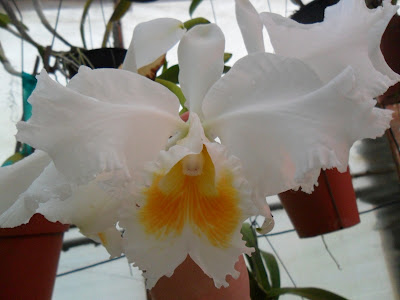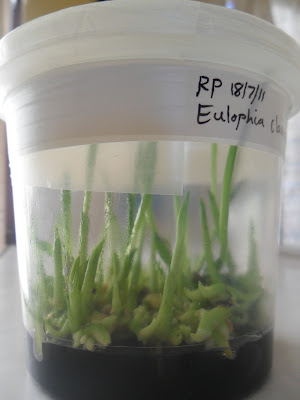I can't believe how quickly this year has passed! It certainly was a busy year for me but I am happy with the year's progress with my orchids. My Phalaenopsis plants have been in perpetual flower almost all year and December is no exception. My wife has been very happy to have a steady supply of cut flowers in the house. Recently my AM/AOS awarded P. Winter Clouds Mendenhall clone flowered. I always wondered what exactly it was that could possibly be special about yet another large white Phalaenopsis. There are so many "copies" available pretty much everywhere but none of them come close to the form and the perfection of this clone's blooms. They are also extremely large flowers and are so heavy that the plant itself has to be weighed down so that the flowers dont pull it over. It is a clone well worth having in any collection.
 |
| Phalaenopsis Winter Clouds Mendenhall (AM/AOS) |
 |
| Close up shot |
I was most fortunate recently to receive a seedling of P. [Penang Girl ‘ Bullseye’ x (violacea courulea x violacea var. Mentawai) X violacea courulea ‘Keighley”] X violacea ‘Carolina Blue’ (Indigo breeding) from Dennis Williams from Somerset West, originally from Mike Boden's greenhouse in the UK. Mike is well known for his stunning blue Phalaenopsis hybrids. I have been nurturing the little seedling for just about a month now and I have now mounted it onto a raft and placed it onto the raft wall with some my other mounted orchids. It has done well so far and has grown a new leaf and some new roots already. The other Phalaenopsis species which I have mounted on the raft wall are growing well and the P. sanderiana is spiking now. There seems to be no end in sight to the length of the spike which is already nearly 50cm long. I am looking forward to seeing the blooms for the first time. Hidden away on the corner of the raft wall is a mounted Dendrobium hybrid (no name) that I photographed earlier in the year when the plant I bought was in bloom. I since took some of the keikis off the mother plant and mounted them and these are in flower now. The mother plant is not in flower though.
 |
| Phalaenopsis seedling from Dennis Williams |
 |
| Mounted Dendrobium hybrid |
In 2009 a new intergeneric hybrid bewteen Angraecum sesquipedale and Doritaenopsis (Phalaenopsis) Ruey Lih Beauty was registered with the RHS. The new genus was named Chouara and the new hybrid was called C. Kaohsiung Dream. This is the only representative of the gensu currently and looking at the photo of the flower it seems a little drab. So, I decided to make some more. I have crossed one of my A. sesquipedale plants with two of my most striking Phalaenopsis hybrids with spots! I guess time will tell but below is a photo of the two pods that have taken.
 |
| Chouara in the making! |
Well, 2012 is just around the corner and there is much to do. I have many baby orchids to tend to in the New Year that will need re-plating and potting up. With my move away from SIGMA to a private lab for media preparations I am also hoping to reduce my overhead costs significantly. Here's to a blooming good New Year! All the best from me and all my plants. I will be back again in January and by then hopefully I will have some photos to present of the first flowering of my Ascocenda hybrid that is spiking now.
 |
| Ascocenda hybrid spikes |











































